Family name: Ruppiaceae Horan.
Synonym(s): [none]
Common name(s): ditch-grass family
*Number of genera/species: 1/9
List of genera records in GRIN-Global
fruit, sometimes with only endocarpendocarp:
the inner layer of the pericarp, if divided into layers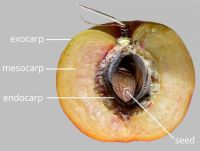 persistent
persistent
Fruit indehiscentindehiscent:
not opening on its own, as in a fruit
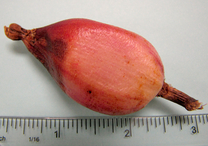 , drupedrupe:
, drupedrupe:
(indehiscent drupe) a fleshy, indehiscent fruit with one more hard pits enclosing seeds, derived from single, superior, simple or compound ovary; (dehiscent drupe) a fruit with a dry or fibrous to fleshy or leathery outer husk that early to tardily breaks apart (or opens), exposing one or more nutlike pits enclosing the seeds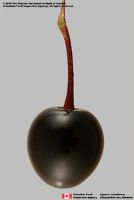 , simple or aggregateaggregate:
, simple or aggregateaggregate:
fruit formed from a single flower with carpels several and distinct , 1.3–4 mm long, ovoidovoid:
, 1.3–4 mm long, ovoidovoid:
3D shape—ovate , flask-shapedflask-shaped:
, flask-shapedflask-shaped:
3D shape—generally circular in cross-section, broadest at or below the middle, approximately globose below that and constricted above to a relatively narrow neck
, or cylindricalcylindrical:
3D shape—a cylinder, with parallel sides and a circular cross-section; tubular or rod-shaped
, tereteterete:
approximately circular in cross section; width and thickness approximately equal
 in transection, beakedbeak:
in transection, beakedbeak:
a usually firm, terminal appendage, sometimes tapered (persistent stylestyle:
(persistent stylestyle:
in a flower, the narrow and elongated part of the pistil between the stigma and the ovary; sometimes persisting in fruit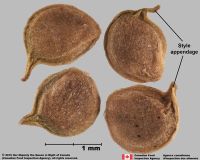 ), often stalked, one-seeded. If an aggregateaggregate:
), often stalked, one-seeded. If an aggregateaggregate:
fruit formed from a single flower with carpels several and distinct , then they resemble an umbel. Pericarppericarp:
, then they resemble an umbel. Pericarppericarp:
fruit wall or fruit coat
green or brown, chartaceouschartaceous:
papery, papyraceous
or spongyspongy:
soft, light, discontinuous but cohesive, and somewhat resilient
, dulldull:
reflecting only a low proportion of incident light, with no apparent sheen , smooth, often decaying. Endocarpendocarp:
, smooth, often decaying. Endocarpendocarp:
the inner layer of the pericarp, if divided into layers persistent and sometimes with a longitudinallongitudinal:
persistent and sometimes with a longitudinallongitudinal:
of or relating to length or the lengthwise dimension
operculum ridge.
Seed 1–4 mm long, attached to endocarpendocarp:
the inner layer of the pericarp, if divided into layers .
.
Embryo well developed, straight or curvedcurved:
(of embryo) linear embryo is curved into an arch or horseshoe with the ends far apart , fills seed coat, with an enlarged hypocotylhypocotyl:
, fills seed coat, with an enlarged hypocotylhypocotyl:
portion of the embryonic axis below the cotyledons and above the radicle
, terminal cotyledoncotyledon:
a primary leaf of the embryo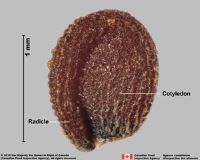 , and laterallateral:
, and laterallateral:
(of embryo) embryo lies along the side of the seed, generally towards one end; of, at, or from the side; in grasses, can refer to the sides adjacent to the dorsal and ventral sides
plumule.
Endosperm absent.
| Fruit | |
| Type | drupedrupe: (indehiscent drupe) a fleshy, indehiscent fruit with one more hard pits enclosing seeds, derived from single, superior, simple or compound ovary; (dehiscent drupe) a fruit with a dry or fibrous to fleshy or leathery outer husk that early to tardily breaks apart (or opens), exposing one or more nutlike pits enclosing the seeds  |
| Size range | 1.3–4 mm long |
| Shape(s) | ovoidovoid: 3D shape—ovate  , flask-shapedflask-shaped: , flask-shapedflask-shaped:3D shape—generally circular in cross-section, broadest at or below the middle, approximately globose below that and constricted above to a relatively narrow neck , cylindricalcylindrical: 3D shape—a cylinder, with parallel sides and a circular cross-section; tubular or rod-shaped |
| Texture | chartaceouschartaceous: papery, papyraceous , spongyspongy: soft, light, discontinuous but cohesive, and somewhat resilient |
| Surface relief | smooth |
| Color(s) | green, brown |
| Unique features | Chartaceouschartaceous: papery, papyraceous or spongyspongy: soft, light, discontinuous but cohesive, and somewhat resilient , green or brown beakedbeak: a usually firm, terminal appendage, sometimes tapered  drupes, often outer layers of the pericarps decay leaving only endocarps, which sometimes bear longitudinallongitudinal: drupes, often outer layers of the pericarps decay leaving only endocarps, which sometimes bear longitudinallongitudinal:of or relating to length or the lengthwise dimension operculum ridges. |
| Seed | |
| Size range | 1–4 mm long |
| Other | |
| Embryo | well developed, straight or curvedcurved: (of embryo) linear embryo is curved into an arch or horseshoe with the ends far apart  , fills seed coat, with an enlarged hypocotylhypocotyl: , fills seed coat, with an enlarged hypocotylhypocotyl:portion of the embryonic axis below the cotyledons and above the radicle , terminal cotyledoncotyledon: a primary leaf of the embryo  , and laterallateral: , and laterallateral:(of embryo) embryo lies along the side of the seed, generally towards one end; of, at, or from the side; in grasses, can refer to the sides adjacent to the dorsal and ventral sides plumule |
| Nutritive tissue | endosperm absent |
Worldwide.
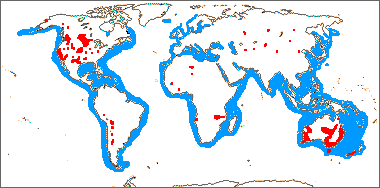
Distribution map courtesy of Angiosperm Phylogeny Website.
Baskin and Baskin 2021Baskin and Baskin 2021:
Baskin C and Baskin J. 2021. Relationship of the lateral embryo (in grasses) to other monocot embryos: A status up-grade. Seed Science Research 31 (3): 199-210. doi:10.1017/S0960258521000209; Bobrov and Romanov 2019Bobrov and Romanov 2019:
Bobrov AVFCH and Romanov MS. 2019. Morphogenesis of fruits and types of fruit of angiosperms. Botany Letters 166 (3): 366-399. https://doi.org/10.1080/23818107.2019.1663448; Cronquist 1981Cronquist 1981:
Cronquist A. 1981. An integrated system of classification of flowering plants. Columbia University Press, New York. 1261 pp.; Dahlgren et al. 1985Dahlgren et al. 1985:
Dahlgren RMT, Clifford HT, and Yeo PF. 1985. The families of the monocotyledons: structure, evolution, and taxonomy. Springer-Verlag, Berlin. 520 pp.; Flora of Australia 2021+Flora of Australia 2021+:
Flora of Australia. Australian Biological Resources Study, Canberra. Accessed January 2021–March 2024. URL: http://www.ausflora.org.au; Flora of North America Editorial Committee 1993+Flora of North America Editorial Committee 1993+:
Flora of North America Editorial Committee, eds. 1993+. Flora of North America North of Mexico [Online]. 22+ vols. Flora of North America Association, New York and Oxford. Accessed January-March 2024. URL: http://beta.floranorthamerica.org.; Kirkbride et al. 2006Kirkbride et al. 2006:
Kirkbride JH, Jr, Gunn CR, and Dallwitz MJ. 2006. Family guide for fruits and seeds, vers. 1.0. Accessed September 2020-January 2022. URL: https://nt.ars-grin.gov/seedsfruits/keys/frsdfam/index.cfm .; Kubitzki et al. 1990+Kubitzki et al. 1990+:
Kubitzki K et al., eds. 1990+. The families and genera of vascular plants. 7+ vols. Berlin etc.; Martin and Barkley 1961Martin and Barkley 1961:
Martin AC and Barkely WD. 1961. Seed Identification Manual. Universisty of California Press, Berkeley and Los Angeles, CA, USA. 220 pp.; Watson and Dallwitz 1992+Watson and Dallwitz 1992+:
Watson L and Dallwitz MJ. 1992+. The families of flowering plants: descriptions, illustrations, identification, and information retrieval. Version: 6th Accessed September 2020-September 2022. URL: delta-intkey.com; Zhengyi et al. 2004+Zhengyi et al. 2004+:
Zhengyi W, Raven PH, and Deyuan H. 2004+. Flora of China [online]. 25 vols. Science Press, Beijing China & Missouri Botanical Garden, St. Louis USA. Accessed January–March 2024. http://flora.huh.harvard.edu/china/
*The number of genera and species is based on Christenhusz and Byng 2016Christenhusz and Byng 2016:
Christenhusz MJM and Byng JW. 2016. The number of known plant species in the world and its annual increase. Phytotaxa 261 (3): 201-217. https://doi.org/10.11646/phytotaxa.261.3.1, which may differ from the number of genera in GRIN-Global.